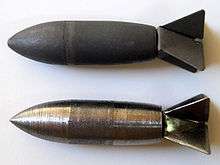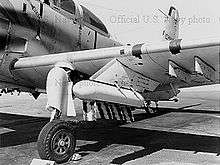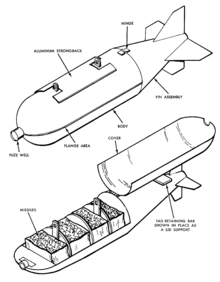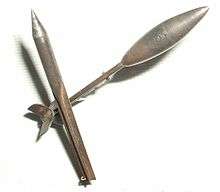Lazy Dog (bomb)




Lazy Dog projectiles (sometimes called Red Dot Bombs or Yellow Dog Bombs) are small, unguided kinetic projectiles, each measuring 1.75 inches (44 mm) in length, 0.5 inches (13 mm) in diameter, and weighing 207 grains, about 0.47 ounces (13 g).
The weapons were designed to be dispersed over the battlefield with Mark 44 cluster adapters. Lazy dog projectiles were technically not bombs because they used no explosive, but were in many ways equally destructive. Mark 44 cluster adapters were one of many possible means to deliver "Lazy Dog" projectiles.
Lazy dog projectiles were used primarily during World War II, the Korean War, and the Vietnam War.
Development
Lazy dog bombs were descended from projectiles of almost identical design and appearance that were originally developed early in World War II as early as 1941. The Korean War-era and Vietnam War-era "Lazy Dog" was further developed, tested and deployed into the 1950s and 1960s.
Originally an Armament Laboratory program codenamed Lazy Dog, the weapon's development involved Delco Products Corporation, F&F Mold and Die Works, Inc., Haines Designed Products, and Master Vibrator Company of Dayton.[1] The project objective was to design and test free-fall missiles and their dispensing units for use in bombers and fighters. Lazy Dog anti-personnel missiles were designed to spray enemy troops with small projectiles with three times the force of standard air-burst bombs. The Armament Laboratory worked with the Flight Test Laboratory to conduct wind tunnel tests of a number of bomb shapes which design studies indicated to be the most efficient for stowage and release from high performance aircraft.
Experimental Lazy Dog projectiles of various shapes and sizes were tested at Air Proving Ground, Eglin AFB, Florida, in late 1951 and early 1952. An F-84 flying at 400 knots and 75 feet (23 m) above the ground served as the test bed while a jeep and a B-24 were the targets. The result was eight hits per square yard. Tests revealed Shapes 2 and 5 to be the most effective. Shape 5, an improved basic Lazy Dog slug, had the force of a .50 caliber bullet and could penetrate 24 inches (61 cm) of packed sand. Shape 2 could penetrate 12 inches (30 cm) of sand — twice as much as a .45 caliber slug fired point blank.
Deployment
The Shape 2 projectile was sent to the Far East Air Force for combat use by mid-1952. FEAF immediately ordered 16,000 Lazy Dog weapon systems. An Air Force Lieutenant Colonel named Haile attached to the Armament Laboratory spent 90 days in Japan to set up local manufacture of the Lazy Dog weapons and train crew members in their use. Project Lazy Dog continued throughout 1952 to determine the optimum characteristics for stable dispersion containers and the feasibility of substituting a Lazy Dog warhead for the explosive nose of the Matador missile. The Lazy Dog program was still ongoing in the late 1950s.
The rationale for using Lazy Dogs in the Vietnam War was their effectiveness against enemy troops hidden beneath the jungle canopy. The munitions were also cheap and easy to scatter over large areas. Like many other weapons, however, their effects were often gruesome and indiscriminate. "Lazy Dog" projectiles were also referred to by other names such as "lawn darts" or "buzz bombs" (V-1 flying bomb) because of their similar shape to both those objects.
Lazy Dog projectiles were dropped in very large numbers, and usable with almost any kind of flying vehicle. They could be hurled from buckets, dropped by hand, thrown in their small shipping bags made of paper, or placed in a Mark 44 cluster adapter—a simple hinged casing with bins built in to hold the projectiles, opened by a mechanical time delay fuze as shown. The adapters themselves were 69.9 inches long and 14.18 inches in diameter. They would be shipped empty, then filled by hand. Depending on how many projectiles could be packed in, loaded weight varied between 560 and 625 pounds, with the theoretical maximum number of projectiles listed as 17,500.
Regardless of how they were released into the air, each "Lazy Dog" projectile would develop an enormous amount of kinetic energy as it fell, penetrating nearly any material upon hitting the ground. Some reports say that their speeds often exceeded 500 mph before impact.
A variant version of the "Lazy Dog" projectile was developed for the recoilless rifle. However, development was suspended because another kind of flechette solution was used for the recoilless rifle instead.
References
- ↑ Tagg, Lori S. (2001). "7". On The Front Line Of R&D. ASC History Office. Archived from the original on 1 September 2010.